Case Studies
SCHOOLS/ MUNICIPAL
SCHOOL: The project engineer was faced with designing a wastewater treatment system for a school in rural Alabama that was consolidating and increasing enrollment from 400 students to over 1,000. Previously, the school had a failing mound system for their wastewater treatment and with additional classrooms, gymnasium and sports fields; there was little of the site left for a wastewater system. Adding to this dilemma was extremely poor soils.
However, a small stream ran along the property boundary and after thorough analysis and stream modeling, it was determined that the stream could be permitted for wastewater disposal if the treatment system could meet reuse quality effluent of <5 mgl BOD and < 7 TSS. A 30,000 gallon per day (gpd) onsite wastewater treatment unit was installed with ultraviolent (UV) disinfection. The pre-engineered, factory built system was housed in fiberglass tanks, thus allowing the units to be buried out of sight and odor free. Even with significant variances in the system flow, it has had no difficulty in meeting the reuse standards.
(Return to SCHOOLS/MUNICIPAL/PUBLIC FACILITIES)
(Return to all case studies)
-
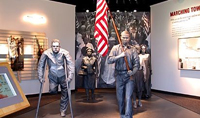
PUBLIC FACILITY: Through a collaborative effort between the National Park Service, the Federal Highway Administration and the State of Alabama, an Interpretive Center was constructed that provides a reservoir of information on the events that occurred during the historical civil rights march from Selma to Montgomery....but it almost did not happen.
-
The site selected for the Interpretive Center was halfway between the 2 cities on U.S. Highway 80 where there was no centralized sewer available. The best available option was an onsite wastewater treatment system, but the limited property size and landscaping required it to be buried and out of sight. A WinnSystems fiberglass unit provided the solution.
Since the number of visitors varies significantly day to day, WinnSystems proven technology meets the challenges of both peak flow demands and minimal usage.
(Return to SCHOOLS/MUNICIPAL)
(Return to all case studies)
RESIDENTIAL SUB-DIVISIONS
-
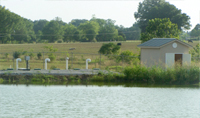
SUB-DIVISION: A small water system provider located in the southern portion of Alabama had a sub-division served by them that also had a facultative lagoon treating their wastewater and discharging into a nearby stream.
-
Updated permit requirements by the State, required a significant increase in the level of treatment quality for their lagoon. After considering various options for upgrading the treatment capabilities of the lagoon, a packaged WinnSystems treatment unit was added between the lagoon and its discharge point at the stream.
The Packaged Recirculating Media Filter unit met and exceeded the higher effluent requirements dictated by the State regulators and a Ultraviolet (UV) Disinfection unit was used to provide pathogen inactivation prior to disposal. WinnSystems provided the lowest operation and maintenance cost of all the systems evaluated.
(Return to SUBDIVISIONS)
(Return to all case studies)
-
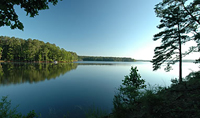
SUB-DIVISION: A construction company that had earlier installed a WinnSystems unit on the North Carolina coast encouraged this lakeside developer to consider utilizing a similar system. The project included 101 residential lots along with several multi-family condominium units
-
WinnSystems teamed with a reputable soils scientist group to evaluate wastewater disposal options for this pristine lake development. The challenge was designing a system that permitted maximum land utilization while meeting the environmental requirements on a reservoir used for drinking water.
A TITAN MBR (Membrane Biological Reactor) treatment unit was chosen, designed and permitted. It meets reuse/reclaim effluent and utilizes spray fields for effluent disposal. The MBR’s modular design allowed for an efficient installation with a minimum footprint.
(Return to CONDOMINIUMS)
(Return to all case studies)
CONDOMINIUMS
-
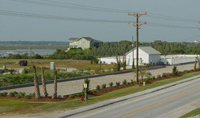
CONDOMINIUM: The original developers of a 54-unit ocean front/sound development built on Topsail Island (NC) during the 1970s were looking at potential options to maximize the remaining undeveloped site. The wastewater treatment for the existing development was an aging 15,000 gallon per day (GPD) system with a disposal field located on some of the prime underdeveloped property.
-
WinnSystems was approached by the developer and asked to evaluate his options. In this instance it was decided the best approach was to determine the maximum amount of development that was possible on the remaining site. It was calculated that the site had the capacity to treat and dispose of an additional 21,000 gpd of wastewater, which provided the developer the capability of adding up to 161 more bedrooms. Around the same time, the Condo Owners Association (COA) was working with the NC State Regulators to find solutions for replacing the aging 15,000 gpd wastewater treatment system presently serving their condos.
Recognizing a workable solution for all parties concerned, WinnSystems meshed their needs into a combined wastewater treatment system. It was a pre-engineered, factory built, 36,000 gpd WinnSystems wastewater treatment unit, housed in non-corrosive fiberglass tanks. Both the new wastewater treatment plant and its disposal field were designed, permitted and installed while the existing system remained operable until startup of the new system.
(Return to CONDOMINIUMS)
(Return to all case studies)
-
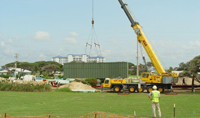
CONDOMINIUM: WinnSystems was working with a developer, looking for the best wastewater treatment options available to serve his sound side development, a high-rise condominium project located on a barrier island near Morehead City.
-
With high land costs, options to maximize the current site were important. During this time, a nearby ocean side property had issues with an aging system that required replacement.
With encouragement from North Carolina regulators, WinnSystems and the developer approached the COA located on the ocean side about the possibility of combining efforts and utilizing a single system to serve both properties. It was determined that the combined wastewater flow would require a 101,000 gpd system with the challenge of keeping the ocean side condominium’s then current system operational while the new system was installed. After detailed soil analysis and supporting data, it was determined that it was possible to use the existing subsurface disposal field that had treatment requirements of reuse/reclaim wastewater treatment.
WinnSystems designed and permitted a TITAN MBR (Membrane Biological Reactor) treatment system that allowed a much larger system to fit on the limited existing footprint of the ocean side property while meeting the required reuse/reclaim wastewater treatment standards for the existing field.
(Return to CONDOMINIUMS)
(Return to all case studies)
-
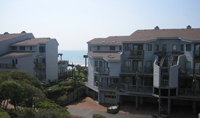
CONDOMINIUM: Wastewater treatment options for replacing the old, corroded and inefficient treatment plant serving this ocean front development were being considered by the COA when WinnSystems was introduced to the project.
-
The 22 year old existing plant was not meeting the State’s regulatory requirements and was under a Special Order of Compliance to present a plan and schedule the removal and replacement of the failing wastewater plant. WinnSystems, working with their engineer, faced a challenge of designing a system that would meet the new treatment requirements of the State while fitting into the existing system's small footprint.
A WINN-SBR (Sequencing Batch Reactor) configured in a fiberglass tank and installed below grade was the right solution. The fiberglass tank has proven to be the best container for withstanding the harsh oceanfront environment. The compact size of the WINN-SBR allowed for fitting the new efficient treatment plant into the footprint of the old activated sludge plant and meeting the regulatory requirement for nutrient removal.
(Return to CONDOMINIUMS)
(Return to all case studies)
INDUSTRIAL SITES
-
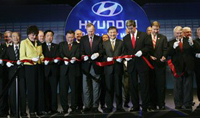
INDUSTRIAL SITE: Hyundai Motor America's location in Montgomery, AL resulted in numerous automotive suppliers seeking plant locations in neighboring towns. One such community, located between Montgomery and Mobile, had an industrial site which did not have sewer available.
-
The ability to extend sewer was not an economic option. The engineering firm retained by the county sought input from WinnSystems. The site had non-porous soils, and it did not appear that utilizing conventional drain fields was a viable solution; however, a stream along the backside of the property provided an opportunity. Analysis determined the stream could be utilized for disposal contingent upon the effluent being treated to reuse quality.
A pre-engineered, factory built, WinnSystems Packaged Recirculating Media Filter unit in a below grade fiberglass tank was specified, permitted and installed.
Quick links to projects:
- Schools/Public Facilities
- Sub-Divisions
- Condominiums
- Industrial Sites
- Commercial and Shopping Centers
- Marinas
- Resorts
- Mobile Home Parks
- FastFact
1.2 billion people worldwide do not have access to clean water.

